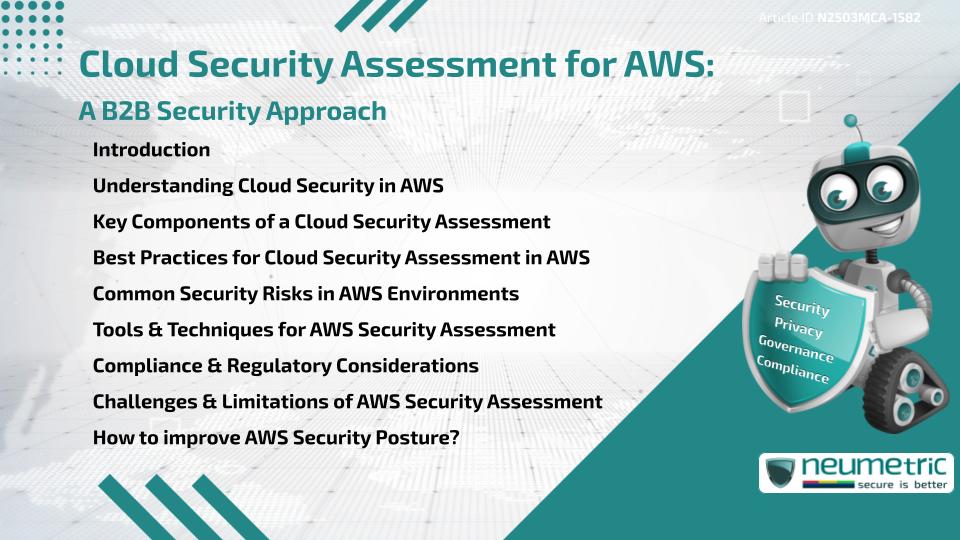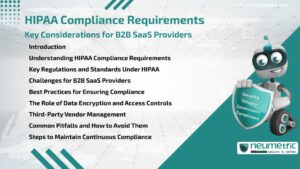Table of Contents
ToggleIntroduction
Cloud Security is a critical concern for Businesses using Amazon Web Services [AWS]. A Cloud Security Assessment for AWS helps Organisations evaluate Vulnerabilities, ensure Compliance & improve their Security Posture. This Cloud Security Assessment for AWS: A B2B Security Approacharticle explores the key aspects of AWS Security Assessment, best practices & common challenges.
Understanding Cloud Security in AWS
AWS provides a shared responsibility model where Amazon secures the Infrastructure while Customers are responsible for securing their Data, Applications & Configurations. A Cloud Security Assessment for AWS helps Organisations identify potential Weaknesses & mitigate Risks proactively.
Key Components of a Cloud Security Assessment
A Cloud Security Assessment for AWS typically includes:
- Identity & Access Management [IAM]: Ensuring proper User Authentication & Role-based Access Control.
- Network Security: Reviewing Virtual Private Cloud [VPC] configurations, firewalls & security groups.
- Data Protection: Assessing Encryption Standards for Data at rest & in transit.
- Application Security: Identifying Vulnerabilities in hosted Applications & APIs.
- Compliance & Audit Trails: Reviewing Logs & Security Controls to meet regulatory requirements.
Best Practices for Cloud Security Assessment in AWS
To ensure a strong security posture, Organisations should:
- Regularly conduct Security Assessments & Penetration Tests.
- Implement Multi-factor Authentication [MFA] for all accounts.
- Automate Security Monitoring using AWS Security Hub.
- Restrict permissions following the Principle of Least Privilege.
- Encrypt Sensitive Data & enforce Secure Access Policies.
Common Security Risks in AWS Environments
Organisations face several Security Risks in AWS, including:
- Misconfigured S3 Buckets: Exposing Sensitive Data due to incorrect settings.
- Weak IAM Policies: Granting excessive privileges to Users & Applications.
- Unpatched Vulnerabilities: Leaving workloads vulnerable to exploits.
- Insecure APIs: Allowing Unauthorised Access to Backend Services.
- Lack of Monitoring: Failing to detect malicious activities in real time.
Tools & Techniques for AWS Security Assessment
Organisations can leverage several tools to conduct a Cloud Security Assessment for AWS, such as:
- AWS Security Hub: Centralised Security Monitoring & Compliance checks.
- Amazon GuardDuty: Threat detection service using Machine Learning.
- AWS Config: Continuous Monitoring for Policy Compliance.
- AWS Inspector: Automated Vulnerability Assessments for workloads.
- Third-party Penetration Testing Tools: Tools like Nessus & Burp Suite for in-depth testing.
Compliance & Regulatory Considerations
A Cloud Security Assessment for AWS must align with Industry Regulations such as:
- General Data Protection Regulation [GDPR]: Data protection requirements for Businesses handling EU Citizens’ Data.
- Health Insurance Portability & Accountability Act [HIPAA]: Security rules for Healthcare Organisations.
- Payment Card Industry Data Security Standard [PCI DSS]: Compliance for Businesses processing Credit Card Transactions.
- ISO 27001: International Standard for Information Security Management.
Challenges & Limitations of AWS Security Assessment
Despite the benefits, Cloud Security Assessments face some challenges:
- Complex Configurations: Managing multiple security settings across AWS Services.
- Rapidly Changing Environments: Adapting to new Updates & Security Policies.
- Skill Gaps: Organisations may lack in-house expertise for thorough Assessments.
- False Positives: Identifying relevant Threats among large volumes of Alerts.
How to improve AWS Security Posture?
To strengthen security, Businesses should:
- Continuously update Security Policies based on evolving Threats.
- Conduct regular training for Teams on AWS Security Best Practices.
- Integrate Security Tools with automated response mechanisms.
- Adopt a Zero Trust approach by verifying every access request.
- Engage Third-Party Security Experts for Independent Audits.
Conclusion
A Cloud Security Assessment for AWS is essential for Businesses to protect their Cloud Environments, ensure Compliance & prevent Security Threats. By following Best Practices, leveraging Security Tools & addressing Key Challenges, Organisations can strengthen their AWS Security Posture effectively.
Takeaways
- A Cloud Security Assessment for AWS helps Organisations identify & mitigate Security Risks.
- Best Practices include regular Audits, strict IAM Controls & automated Security Monitoring.
- Compliance with GDPR, HIPAA & PCI DSS is essential for Regulated Industries.
- Businesses must address challenges such as Configuration complexity & Skill Gaps to enhance security.
FAQ
What is a Cloud Security Assessment for AWS?
A Cloud Security Assessment for AWS is a process of evaluating Security Risks, Configurations & Compliance Requirements to protect AWS Environments from Threats.
How often should a Cloud Security Assessment for AWS be conducted?
Organisations should perform Security Assessments at least quarterly or after significant infrastructure changes to maintain a strong security posture.
What Tools can help with a Cloud Security Assessment for AWS?
AWS Security Hub, Amazon GuardDuty, AWS Inspector & Third-Party Tools like Nessus & Burp Suite are commonly used for Security Assessments.
What are the common Vulnerabilities found in a Cloud Security Assessment for AWS?
Misconfigured S3 buckets, Weak IAM Policies, Unpatched Software, Insecure APIs & insufficient Monitoring are common security Vulnerabilities in AWS Environments.
How does AWS ensure security in its Cloud Infrastructure?
AWS secures its infrastructure using Built-in Protections, Encryption, Compliance Frameworks & a shared responsibility model where Customers manage their own Security Settings.
Can a Cloud Security Assessment for AWS help with Compliance?
Yes, a Cloud Security Assessment for AWS helps Organisations meet Compliance Requirements for regulations like GDPR, HIPAA & PCI DSS by identifying Security Gaps.
What are the benefits of conducting a Cloud Security Assessment for AWS?
Benefits include enhanced Threat Detection, improved Compliance, better Risk Management & a more resilient Security Posture.
Need help?
Neumetric provides organisations the necessary help to achieve their Cybersecurity, Compliance, Governance, Privacy, Certifications & Pentesting goals.
Organisations & Businesses, specifically those which provide SaaS & AI Solutions, usually need a Cybersecurity Partner for meeting & maintaining the ongoing Security & Privacy needs & requirements of their Clients & Customers.
SOC 2, ISO 27001, ISO 42001, NIST, HIPAA, HECVAT, EU GDPR are some of the Frameworks that are served by Fusion – a centralised, automated, AI-enabled SaaS Solution created & managed by Neumetric.
Reach out to us!





